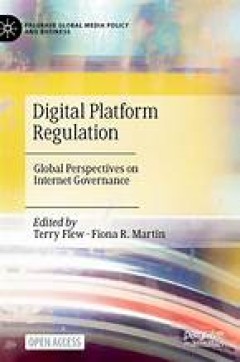Filter by

Digital Platform Regulation
This Open Access volume provides an in-depth exploration of global policy and governance issues related to digital platform regulation. With an international ensemble of contributors, the volume has at its heard the question: what would actually be involved in digital platform regulation?’. Once a specialised and niche field within internet and digital media studies, internet governance has i…
- Edition
- 1
- ISBN/ISSN
- 978-3-030-95220-4
- Collation
- -
- Series Title
- Palgrave Global Media Policy and Business
- Call Number
- XVII, 319

Kollektive Informationsverarbeitung von Medieninhalten: Theoriebildung, Metho…
Das vorliegende Open-Access-Buch leistet einen zusammenhängenden theoretischen, methodischen und empirischen Beitrag zum Verständnis von Informationsverarbeitung in Gruppen. Menschen nutzen und verarbeiten Medieninhalte häufig gemeinsam. Trotzdem gibt es erst wenig und vornehmlich auf die Individualebene fokussierte Forschung zu kollektiver Medienrezeption bzw. kollektiver Informationsverarb…
- Edition
- -
- ISBN/ISSN
- 9783658425333
- Collation
- XVII, 265
- Series Title
- -
- Call Number
- -

Foundations of Software Science and Computation Structures: 21st Internationa…
Buku ini merupakan hasil dari Konferensi Internasional ke-21 tentang Fondasi Ilmu Perangkat Lunak dan Struktur Komputasi, FOSSACS 2018, yang berlangsung di Thessaloniki, Yunani, pada bulan April 2018, yang diselenggarakan sebagai bagian dari Konferensi Gabungan Eropa tentang Teori dan Praktik Perangkat Lunak, ETAPS 2018. 31 makalah yang disajikan dalam volume ini ditinjau dengan cermat dan dipi…
- Edition
- 1
- ISBN/ISSN
- 9783319893662
- Collation
- XV, 583
- Series Title
- -
- Call Number
- 004.1 BAI f

Handbook of Open, Distance and Digital Education
- Edition
- -
- ISBN/ISSN
- 9789811903519
- Collation
- -
- Series Title
- -
- Call Number
- -
- Edition
- -
- ISBN/ISSN
- 9789811903519
- Collation
- -
- Series Title
- -
- Call Number
- -

Information and Knowledge Organisation in Digital Humanities : Global Perspec…
- Edition
- -
- ISBN/ISSN
- 9781003131816
- Collation
- -
- Series Title
- -
- Call Number
- -
- Edition
- -
- ISBN/ISSN
- 9781003131816
- Collation
- -
- Series Title
- -
- Call Number
- -

Smittestopp − A Case Study on Digital Contact Tracing
This open access book describes Smittestopp, the first Norwegian system for digital contact tracing of Covid-19 infections, which was developed in March and early April 2020. The system was deployed after five weeks of development and was active for a little more than two months, when a drop in infection levels in Norway and privacy concerns led to shutting it down. The intention of this book …
- Edition
- -
- ISBN/ISSN
- 978-3-031-05466-2
- Collation
- -
- Series Title
- -
- Call Number
- -

Digital Transformation in Norwegian Enterprises
This open access book presents a number of case studies on digital transformation in Norway, one of the fore-runners in the digital progress index established by the European Commission in 2020. They explore the process of adoption, diffusion and value generation from digital technologies, and how the use of different digital solutions has enabled Norwegian enterprises to digitally transform th…
- Edition
- -
- ISBN/ISSN
- 978-3-031-05276-7
- Collation
- -
- Series Title
- -
- Call Number
- -

Digital Platform Regulation
This Open Access volume provides an in-depth exploration of global policy and governance issues related to digital platform regulation. With an international ensemble of contributors, the volume has at its heard the question: what would actually be involved in digital platform regulation?’. Once a specialised and niche field within internet and digital media studies, internet governance has i…
- Edition
- 1
- ISBN/ISSN
- 978-3-030-95220-4
- Collation
- -
- Series Title
- Palgrave Global Media Policy and Business
- Call Number
- XVII, 319

New Perspectives in Critical Data Studies
This Open Access book examines the ambivalences of data power. Firstly, the ambivalences between global infrastructures and local invisibilities challenge the grand narrative of the ephemeral nature of a global data infrastructure. They make visible local working and living conditions, and the resources and arrangements required to operate and run them. Secondly, the book examines ambivalences …
- Edition
- -
- ISBN/ISSN
- 978-3-030-96180-0
- Collation
- -
- Series Title
- Transforming Communications – Studies in Cross-Media Research
- Call Number
- XXV, 473

Discourse and digital practices : doing discourse analysis in the digital age
- Edition
- -
- ISBN/ISSN
- 9781315726465
- Collation
- -
- Series Title
- -
- Call Number
- -
- Edition
- -
- ISBN/ISSN
- 9781315726465
- Collation
- -
- Series Title
- -
- Call Number
- -
 Computer Science, Information & General Works
Computer Science, Information & General Works  Philosophy & Psychology
Philosophy & Psychology  Religion
Religion  Social Sciences
Social Sciences  Language
Language  Pure Science
Pure Science  Applied Sciences
Applied Sciences  Art & Recreation
Art & Recreation  Literature
Literature  History & Geography
History & Geography